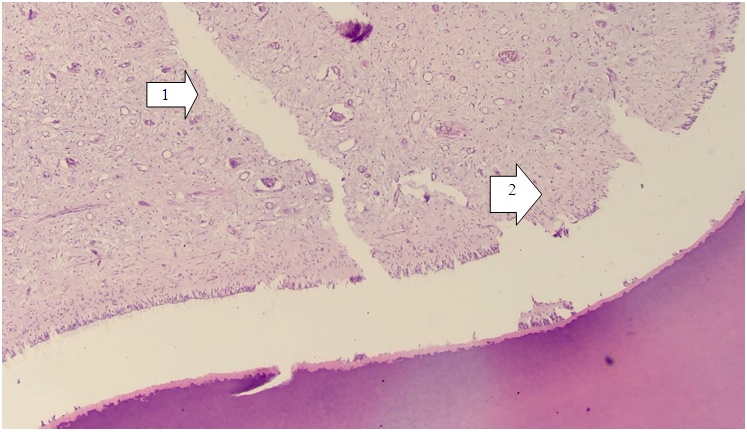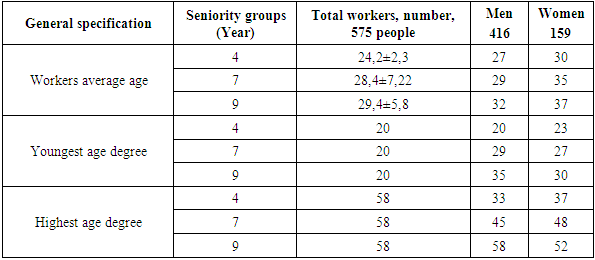-
Paper Information
- Next Paper
- Paper Submission
-
Journal Information
- About This Journal
- Editorial Board
- Current Issue
- Archive
- Author Guidelines
- Contact Us
American Journal of Medicine and Medical Sciences
p-ISSN: 2165-901X e-ISSN: 2165-9036
2025; 15(3): 699-703
doi:10.5923/j.ajmms.20251503.46
Received: Jan. 3, 2025; Accepted: Feb. 10, 2025; Published: Mar. 15, 2025

Periodontal Diseases and Morphological Changes in Employees with Varying Seniority in the Manufacturing Industry
Ravshan Usmanov1, Azamat Nortaev2, Nilufar Nortaeva3, Gulnara Islamova4, Makhmuda Sakdullaeva5, Aliyor Normuradov2, Shakhzoda Ibrakhimova2
1Doctor of Medical Sciences, Professor of the Department of Human Anatomy and OSTA of the Tashkent Medical Academy, Uzbekistan
2Assistant of the Department of Human Anatomy and OSTA, Tashkent Medical Academy, Uzbekistan
3PhD, Senior Teacher of the Department of Human Anatomy and OSTA, Tashkent Medical Academy, Uzbekistan
4Dosent of the Department of Human Anatomy and OSTA, Tashkent Medical Academy, Uzbekistan
5Senior Teacher of the Department of Human Anatomy and OSTA, Tashkent Medical Academy, Uzbekistan
Copyright © 2025 The Author(s). Published by Scientific & Academic Publishing.
This work is licensed under the Creative Commons Attribution International License (CC BY).
http://creativecommons.org/licenses/by/4.0/

This study investigated the impact of air pollution caused by textile combine dyeing and finishing enterprises, specifically the emission of aerosolized paint particles. These aerosols significantly contribute to air contamination and pose health risks to workers. Prolonged exposure to these particles has been linked to various health issues, including tumor development. The aerosol droplets settle on the skin and penetrate the respiratory and digestive systems of workers, leading to adverse morphological changes, particularly in oral and periodontal tissues. The findings highlight that workshops involved in chemical dye production are major contributors to air pollution, dispersing a wide variety of harmful compounds into the environment. Measures to mitigate these occupational hazards are urgently needed to protect the health of employees.
Keywords: Morphological changes, Teeth, Periodontal diseases, Employees, Men, Women, Chemical dyes
Cite this paper: Ravshan Usmanov, Azamat Nortaev, Nilufar Nortaeva, Gulnara Islamova, Makhmuda Sakdullaeva, Aliyor Normuradov, Shakhzoda Ibrakhimova, Periodontal Diseases and Morphological Changes in Employees with Varying Seniority in the Manufacturing Industry, American Journal of Medicine and Medical Sciences, Vol. 15 No. 3, 2025, pp. 699-703. doi: 10.5923/j.ajmms.20251503.46.
Article Outline
1. Introduction
- In periodontal diseases, it has been suggested that tissue damage in one area can spread to other tissues, or alternatively, all affected tissues may become simultaneously infected, leading to the concept of considering them as a unified tissue complex [1,2,3,4,5,11,12]. In the manufacturing industry, particularly in the textile sector, various organic and inorganic dye solutions are extensively used in dyeing and finishing enterprises [6,7,8,9,10,13,14,15]. These chemical dyes and solutions are known to induce autoallergenic reactions by denaturing proteins on the mucous membranes of the skin and respiratory tract [16,17,18,19,20]. Clinical and experimental studies conducted by several researchers among workers in manufacturing enterprises utilizing organic and inorganic compounds have comprehensively demonstrated the negative effects of chemical dyes, reagents, catalysts, and other substances on the tissues of the oral cavity and the entire body [21,22].The purpose of the study. Study of paradont diseases and morphological changes in it in employees with different seniority working in the manufacturing industry.
2. Research Materials and Methods
- Studies from 2021 to 2024, from the Workers of the “Crystal” textile combine, located on the territory of the Yangiyol District Medical Association of the Yangiyol District of the Tashkent region, we selected 575 employees. Of this, 416 (72.34%) are male employees and 159 (27.65%) are female employees. The minimum age for selected employees is 20 years, while the maximum age is 48 years or older. First of all, when studying a number of changes in the oral cavity in employees, parodont levels also paid special attention to the work process in which they actively perform. Paint House departmentLaboratory DepartmentDrying unitFinished fabric sectionFabric coloring sectionIn addition, there are also sections such as bugalteria, cadres. Basically, we divided all the employees of the enterprise into two groups: Group 1, which is not in contact with chemical dyes (control), and group 2, which is in contact with chemical dyes (basic). In addition to periodontal disease in these employees, oral infections, tongue leukoplakia and various stomatitis are also common among them (Table 1).
|
3. Results
- Studies have found that the percentage of periodontal disease in paint shop employees was higher in female employees than in male employees. In addition to periodontal disease, workers in paint shops also suffer from leukoplakia, stomatitis and various inflammations in the oral cavity. For example, periodontal disease was found from 165 employees (28.69%) with up to 4 years of seniority in sex (122 male employees and 43 female employees). They are between 27 and 30 years old and average 24.2±2.3 years. Periodontal disease was also observed in 268 employees (46.61%) with 7-year seniority (199 men and 69 women). Their age, on the other hand, was estimated to be between 29 and 35 years old and an average of 28.4±7.22 years. 142 employees (24.69%) with 9 years of work experience (95 male employees and 47 female employees) reported perodontal disease. In terms of age, however, it was between 32 and 37 years old and averaged 29.4±5.8 years (diagram 1). Alternatively, among employees in contact with chemical dyes (observation group), along with periodontal disease, we can see that oral infections, tongue leukoplakia and various stomatitis are also common, as well as the appearance of cracks in the teeth, bleeding gums, moving teeth and even discoloration of the teeth.In the course of determining whether employees of the textile enterprise “Crystal” had periodont disease, we tried, first of all, not to undermine the work process of employees, not to undermine their performance. That is why we used the shortest methods that determine whether there is periodont disease and at what stage it is. In doing so, we did it in conjunction with the medical officer of the enterprise. In dentistry today, there are many methods that determine the index of oral hygiene and periodontitis (periodontitis). But it is precisely in the short term in the employees of the enterprise, with ready-made laboratory preparations to determine the degree of periodont disease, as well as at what stage:• PI• PMA We used the methods.We also found PI in each selected employee, calculated using the formula below. PI = evaluation of each tooth / number of teethAccording to the resulting result, the degrees of parodont disease were determined, and they are as follows.
|
 | Figure 1. Parodont of the identified employee histological appearance of the tooth. Dentin channels (1) and Sharpey appearance of fibers (2). Staining: hematoxylin-eosin X:10x10 |
 | Figure 2. Subjective examination results in employees of a textile enterprise |
4. Discussion
- The findings of this study highlight the significant impact of occupational exposure to chemical dyes on the periodontal health of employees working in textile combine dyeing and finishing enterprises. The results demonstrate that employees in contact with chemical dyes exhibit a higher prevalence of periodontal diseases, as well as associated complications such as leukoplakia, stomatitis, and other oral infections, compared to those not exposed.Prolonged exposure to aerosolized paint particles and chemical dyes leads to adverse health outcomes. These aerosols act as autoallergenic agents, denaturing proteins on the mucous membranes of the skin and respiratory tract, which significantly contributes to the development of inflammatory conditions in the oral cavity. The correlation between the duration of exposure and the severity of periodontal disease was evident, with longer exposure periods resulting in more advanced stages of periodontitis.The study found a higher prevalence of periodontal disease among female employees compared to males, despite similar exposure conditions. This discrepancy may be attributed to physiological and hormonal differences, as well as potential disparities in immune response and oral hygiene practices.Histological analysis of affected tissues revealed significant pathological changes, including vacuolization of odontoblast cytoplasm, hydropic dystrophy, and enlargement of Sharpey fibers. These findings suggest that chemical exposure not only induces inflammatory responses but also disrupts the structural integrity of periodontal and dental tissues.The study highlights the necessity for improved occupational safety measures in dyeing and finishing enterprises. Regular health screenings, particularly focusing on oral health, are essential for early detection and management of periodontal diseases. Additionally, implementing workplace modifications to reduce aerosol dispersion, such as improved ventilation systems and personal protective equipment, could mitigate health risks.Further studies are needed to explore the long-term effects of occupational exposure on systemic health and to develop targeted interventions for at-risk populations. Investigating the potential role of nutritional and lifestyle factors in mitigating these adverse outcomes could also provide valuable insights.This research provides compelling evidence of the detrimental effects of chemical dyes on the periodontal health of textile workers. Comprehensive health programs and stricter regulatory measures are necessary to protect employees from the occupational hazards associated with chemical dye exposure. By addressing these risks, workplaces can improve the overall well-being and productivity of their workforce.
5. Conclusions
- 1. In addition to periodontal disease, paint shop workers also suffer from leukoplakia, stomatitis and various inflammations in the oral cavity. 2. As a result of our observations, it turned out that in a certain percentage of employees there, depending on seniority, periodontal disease, its development, complications arose, that is, inflammation of the gums, swelling, fragility of teeth were also found.3. Alternatively, among employees in contact with chemical dyes (observation group), along with periodontal disease, we can see that oral infections, tongue leukoplakia and various stomatitis are also common, as well as the appearance of cracks in the teeth, bleeding gums, moving teeth and even discoloration of the teeth.
 Abstract
Abstract Reference
Reference Full-Text PDF
Full-Text PDF Full-text HTML
Full-text HTML
